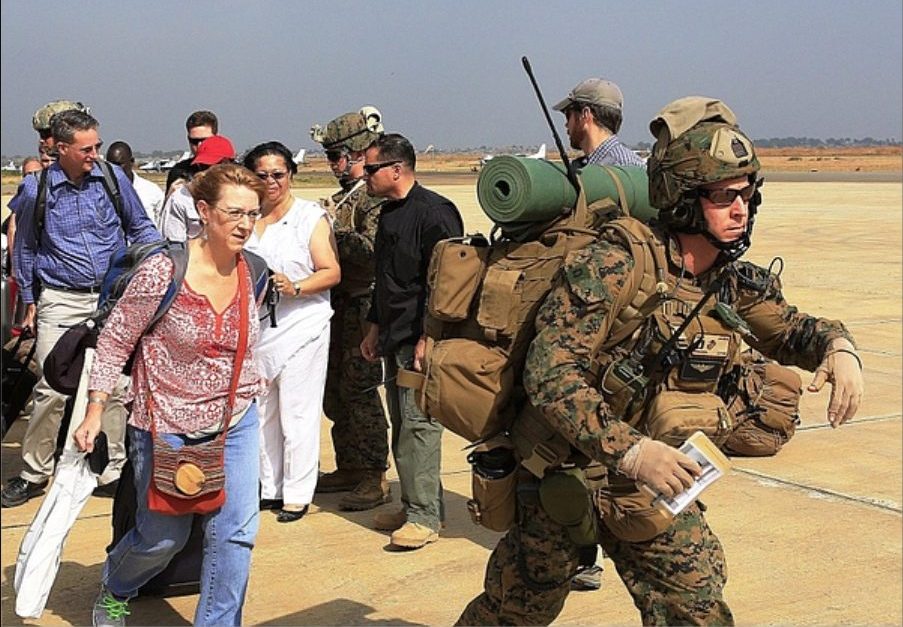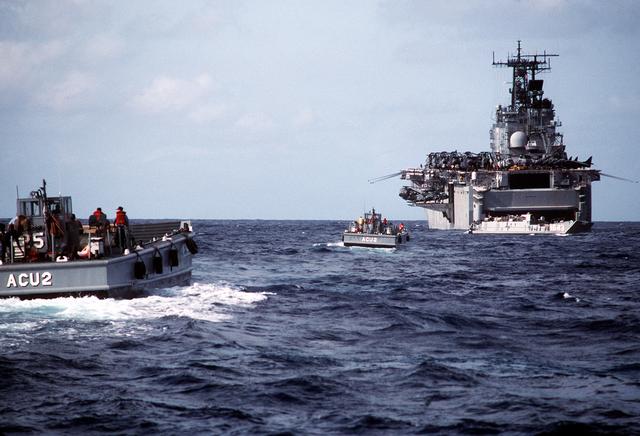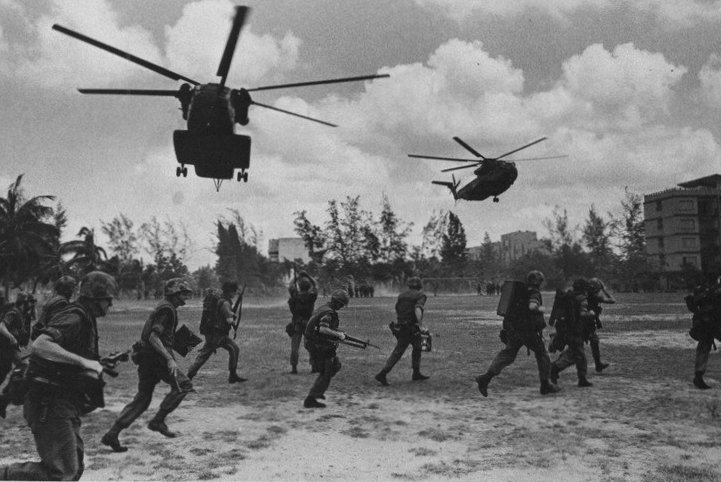
The Pentagon acknowledged on Monday the evacuation of Americans and other U.S. diplomatic personnel from Afghanistan and Afghan emigrants is a “non-combatant evacuation operation,” a mission for U.S. forces to safeguard the exit of civilians and other non-combatants from a country.
Over the weekend, images from the rapid decline of security in Afghanistan – as Taliban forces spread into provincial capitals and, this weekend, into the Afghan capital of Kabul – lent comparisons to the 1975 evacuations in then-South Vietnam’s capital of Saigon.
Afghanistan becomes another in a long line of countries where U.S. service members have been ordered in to provide security and help in the evacuations, a joint mission run by the Department of State and the Department of Defense and guided by Joint Publication 3-68. That document describes a NEO as: “conducted by the Department of Defense (DOD) to assist in evacuating US citizens and nationals, DOD civilian personnel, and designated persons (host nation [HN] and third country nationals [TCNs]) whose lives are in danger from locations in a foreign nation to an appropriate safe haven, when directed by the Department of State (DOS). US policy is contained in a memorandum of agreement between DOD and DOS, titled ‘Memorandum of Agreement between the Departments of State and Defense on the Protection and Evacuation of US Citizens and Nationals and Designated Other Persons from Threatened Areas Overseas.’”
But every NEO mission is different.
Some operations are limited while others are broader in the scope of the evacuations. In some cases, the political and security environment improves and enables the return of civilians; in other cases, the exit is permanent, at least in the near-term. Some NEOs involve the evacuation of the U.S. embassy and Americans, but not all. And in other NEOs, U.S. troops support the evacuations of local foreigners to safer ground. Some NEOs end up with U.S. troops deployed but no evacuation subsequently required.
Past operations have been missions to reinforce the embassy, usually with additional Marines for security. And others are evacuation missions. The latest was in March 2016, when the Department of Defense ordered several hundred U.S. military families to leave Incirlik Air Base in Turkey due to the degrading security environment there. The largest so far was the evacuation of more than 20,000 U.S. service members and their families from Subic Bay Naval Base, Cubi Point Naval Air Station and Clark Air Base after the 1991 volcanic eruption of Mount Pinatubo in the Philippines.
Here’s a look at some of the NEO missions that U.S. military forces conducted in support of the U.S. State Department:
Libya, July 2014

Amid the deteriorating security situation there, several hundred Americans and others were evacuated from the U.S. embassy in Libya’s capital Tripoli by U.S. forces that included Marine Air-Ground Task Force-Crisis Response and MV-22B Osprey tiltrotor aircraft.
South Sudan, January 2014

KC-130s assigned to the Special Purpose Marine Air Ground Task Force – Crisis Response helped evacuate U.S. personnel from the capital city Juba to Uganda.
Japan, Spring 2011

In the aftermath of a devastating earthquake, tsunami and damaged nuclear power plant, the U.S. military helped in the voluntary evacuations of several thousand military family members and others.
Lebanon, July/August 2006

Aircraft along with contracted commercial vessels, Navy ships and units, including the Iwo Jima Expeditionary Strike Group and 24th Marine Expeditionary Unit, evacuated almost 15,000 U.S. citizens from Lebanon and its capital Beirut to Cyprus and Turkey as fighting intensified between Hezbollah militants and Israeli forces. It was one of the largest NEOs since Vietnam.
Bahrain, July 2004

DoD orders temporary evacuation of U.S. military family members from Bahrain, home to the U.S. 5th Fleet, amid threats in the Persian Gulf region.
Haiti, February 2004
A small detachment from 4th Marine Expeditionary Brigade flew to help secure the U.S. embassy in Port-au-Prince and evacuate Americans as the security environment worsened in the island-nation.
Turkey, March 2003
The U.S.-led invasion of Iraq prompted U.S. military officials to evacuate U.S. personnel and families at Incirlik Air Base in neighboring Turkey.
Liberia, Summer 2003

Marine fleet anti-terrorism security teams with the 26th MEU deployed to Liberia to help safeguard the U.S. embassy duriing the ongoing civil war in that African nation in Operation Shining Express
Kuwait, December 1998

The 31st MEU helped evacuate about 90 Americans and diplomats from the U.S. embassy in Kuwait amid the start of Operation Desert Fox, the U.S.-U.K. offensive against suspected Iraqi weapons-of-mass destruction facilities.
Eritrea, June 1998
A group of 11th MEU Marines helped evacuate 172 people, including Americans, via KC-130 Hercules aircraft flying from the capital city Asmara to Jordan amid an ongoing Eritrea-Eithiopia conflict.
Sierra Leone, 1997

In a NEO called Operation Nobel Obelisk, USS Kearsarge (LHD-3) and the 22nd MEU moved some 2,500 Americans and foreigners.
Albania, March 1997

The 26th MEU deployed elements to Tirana, Albania, to help secure the U.S. embassy and helped evacuate 900 people, including Americans, during Operation Silver Wake.
Central African Republic, May 1996
The 22nd MEU deployed to the Central African Republic to assist the U.S. embassy in Operation Quick Response.
Liberia, April 1996

Elements of the 22nd MEU flew to Liberia’s capital Monrovia and helped protect the embassy and evacuate more than 2,000 Americans and others fleeing the country continuing to grapple with civil unrest in, Operation Assured Response.
Rwanda, April 1994

This C-141 flight from Bujumbura, Burundi took on passengers who were fleeing from fighting in Rwanda to Nairobi, Kenya on Jan. 4, 1994. US Marine Corps Photo
Some Marines with the 11th MEU along with Air Force personnel helped evacuate 230 people including Americans from Rwanda during Operation Distant Runner.
Somalia, January 1991

In Operation Eastern Exit, helicopters, Marines and sailors assigned to 1st Battalion, 4th Marines, 4th Marine Expeditionary Brigade flew to Somalia’s besieged capital of Mogadishu and evacuated some 260 Americans and foreigners from the U.S. embassy.
Liberia, 1990-1991

Marines with the 22nd MEU joined U.S. forces in helping evacuate nearly 2,600 people, including 330 Americans in Operation Sharp Edge.
Vietnam, April 1975

Marines and sailors joined in Operation Frequent Wind, the final evacuation missions of Americans and others in the final days before South Vietnam fell to the communist North Vietnamese Army. Some 7,000 people were evacuated by military and civilian helicopters and thousands more by ships.
Cambodia, April 1975

Just a few weeks before Vietnam fell, Operation Eagle Pull, U.S. forces including the then-31st Marine Amphibious Unit from Japan were sent to evacuate Americans from Cambodia’s capital Phnom Penh to Thailand.





